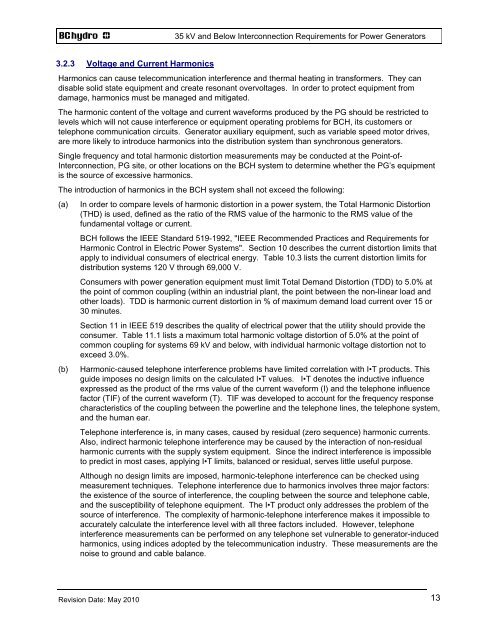35 kV and Below INTERCONNECTION REQUIREMENTS - BC Hydro
35 kV and Below INTERCONNECTION REQUIREMENTS - BC Hydro
35 kV and Below INTERCONNECTION REQUIREMENTS - BC Hydro
Create successful ePaper yourself
Turn your PDF publications into a flip-book with our unique Google optimized e-Paper software.
3.2.3 Voltage <strong>and</strong> Current Harmonics<br />
Revision Date: May 2010<br />
<strong>35</strong> <strong>kV</strong> <strong>and</strong> <strong>Below</strong> Interconnection Requirements for Power Generators<br />
Harmonics can cause telecommunication interference <strong>and</strong> thermal heating in transformers. They can<br />
disable solid state equipment <strong>and</strong> create resonant overvoltages. In order to protect equipment from<br />
damage, harmonics must be managed <strong>and</strong> mitigated.<br />
The harmonic content of the voltage <strong>and</strong> current waveforms produced by the PG should be restricted to<br />
levels which will not cause interference or equipment operating problems for <strong>BC</strong>H, its customers or<br />
telephone communication circuits. Generator auxiliary equipment, such as variable speed motor drives,<br />
are more likely to introduce harmonics into the distribution system than synchronous generators.<br />
Single frequency <strong>and</strong> total harmonic distortion measurements may be conducted at the Point-of-<br />
Interconnection, PG site, or other locations on the <strong>BC</strong>H system to determine whether the PG’s equipment<br />
is the source of excessive harmonics.<br />
The introduction of harmonics in the <strong>BC</strong>H system shall not exceed the following:<br />
(a) In order to compare levels of harmonic distortion in a power system, the Total Harmonic Distortion<br />
(THD) is used, defined as the ratio of the RMS value of the harmonic to the RMS value of the<br />
fundamental voltage or current.<br />
<strong>BC</strong>H follows the IEEE St<strong>and</strong>ard 519-1992, "IEEE Recommended Practices <strong>and</strong> Requirements for<br />
Harmonic Control in Electric Power Systems". Section 10 describes the current distortion limits that<br />
apply to individual consumers of electrical energy. Table 10.3 lists the current distortion limits for<br />
distribution systems 120 V through 69,000 V.<br />
Consumers with power generation equipment must limit Total Dem<strong>and</strong> Distortion (TDD) to 5.0% at<br />
the point of common coupling (within an industrial plant, the point between the non-linear load <strong>and</strong><br />
other loads). TDD is harmonic current distortion in % of maximum dem<strong>and</strong> load current over 15 or<br />
30 minutes.<br />
Section 11 in IEEE 519 describes the quality of electrical power that the utility should provide the<br />
consumer. Table 11.1 lists a maximum total harmonic voltage distortion of 5.0% at the point of<br />
common coupling for systems 69 <strong>kV</strong> <strong>and</strong> below, with individual harmonic voltage distortion not to<br />
exceed 3.0%.<br />
(b) Harmonic-caused telephone interference problems have limited correlation with I•T products. This<br />
guide imposes no design limits on the calculated I•T values. I•T denotes the inductive influence<br />
expressed as the product of the rms value of the current waveform (I) <strong>and</strong> the telephone influence<br />
factor (TIF) of the current waveform (T). TIF was developed to account for the frequency response<br />
characteristics of the coupling between the powerline <strong>and</strong> the telephone lines, the telephone system,<br />
<strong>and</strong> the human ear.<br />
Telephone interference is, in many cases, caused by residual (zero sequence) harmonic currents.<br />
Also, indirect harmonic telephone interference may be caused by the interaction of non-residual<br />
harmonic currents with the supply system equipment. Since the indirect interference is impossible<br />
to predict in most cases, applying I•T limits, balanced or residual, serves little useful purpose.<br />
Although no design limits are imposed, harmonic-telephone interference can be checked using<br />
measurement techniques. Telephone interference due to harmonics involves three major factors:<br />
the existence of the source of interference, the coupling between the source <strong>and</strong> telephone cable,<br />
<strong>and</strong> the susceptibility of telephone equipment. The I•T product only addresses the problem of the<br />
source of interference. The complexity of harmonic-telephone interference makes it impossible to<br />
accurately calculate the interference level with all three factors included. However, telephone<br />
interference measurements can be performed on any telephone set vulnerable to generator-induced<br />
harmonics, using indices adopted by the telecommunication industry. These measurements are the<br />
noise to ground <strong>and</strong> cable balance.<br />
13
















